Learning how to ride a clutch dirt bike is an essential skill in dirt bike riding.
In this post, we will cover the basic principles on dirt bike riding and explain how to ride a clutch dirt bike. We also share how to correctly setup the clutch lever and how to use the clutch properly.
Learning how to ride a clutch dirt bike takes a little practice, however there are several small practices you can do to learn proper clutch operation. Precise dirt bike clutch control is an essential skill for any beginner and technical dirt bike rider. Getting better at dirt bike clutch control involves setting up the forward controls correctly and doing few basic clutch control exercises.
With these dirt bike setup tips and exercises, you can learn how to ride a clutch dirt bike in a matter of few days.
In this article, you will find out:
Let’ s get started.
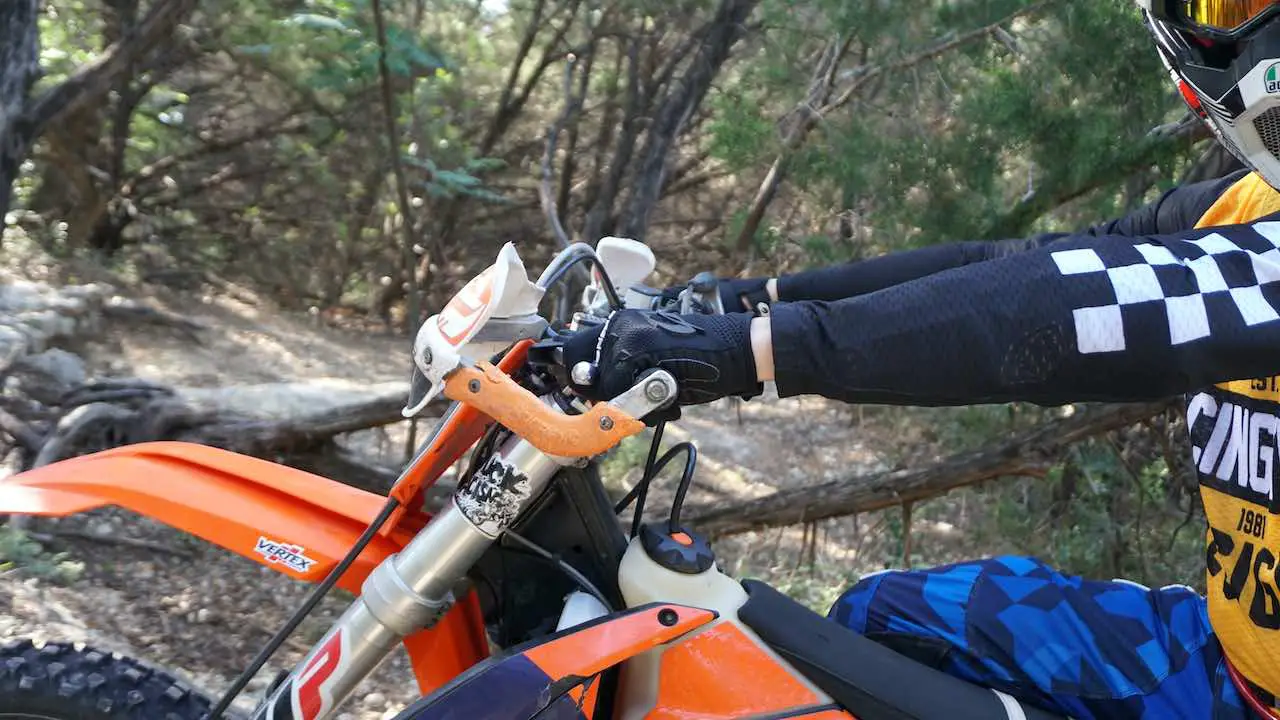
Things You Need to Know About Riding a Clutch Dirt Bike
Alright, let’s begin with the basics. Most adult size gas operated dirt bikes typically come with a clutch and gears, which are part of the motorcycle transmission. Clutch is part of the system that transfers power to the rear wheel.
There are few exceptions to clutches; electric dirt bikes and using a Rekluse clutch.
In both cases using the clutch is not needed or is using it is different than with stock dirt bikes. Recently there has been a lot of new electric dirt bikes rushing to the markets (such as the popular Surron X), and most of them no longer use user operated clutches, which makes them easy for people not wanting to use clutch for various reasons.
So, learning how to ride a clutch dirt bike is basically a must for most dirt bikers.
How Does a Clutch Work on a Dirt Bike or a Motorcycle?
Let’s first talk about how the clutch works on any dirt bike or motorcycles and then focus on how to use it properly and how to ride a clutch dirt bike.
The clutch lever is located on the left side of the handlebar. When the lever is pulled in, the clutch plates inside the motor are pushed apart making them slip. This disconnects the engine power from the drive, meaning the dirt bike is no longer being moved by the engine through the gears, front sprocket, chain and tires.
Pulling the clutch lever in causes a slave cylinder and it’s piston to push a transfer rod deeper inside the clutch basket. The piston pushes the transfer rod, which is connected to a clutch plate, deeper into the clutch basket causing the clutch master plate to disengage the clutch slip plates. This causes clutch slippage and the motor disconnecting from rotating the drive components inside the gearbox.
The more the clutch lever is pushed in, the further the clutch plates are from another increasing clutch slippage. When you pull the lever fully in, the motor is completely disconnect. When letting the clutch lever out, the opposite happens and the clutch engages.
Common Clutch Terminology and Principles Explained
There are few things you should know about dirt bike clutches. Here we are summarizing the most common terminology to make it easier to understand what happens when learning how to ride a clutch dirt bike.
What Does Clutch Engaging Mean?
When you depress the clutch lever and the clutch is engaging and starts to move the dirt bike.
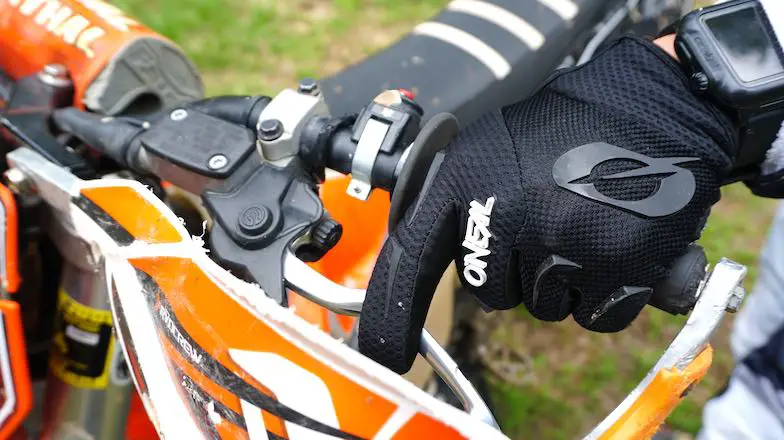
What Does Clutch Disengaging Mean?
When you pull in the clutch lever to stop the dirt bike from moving.
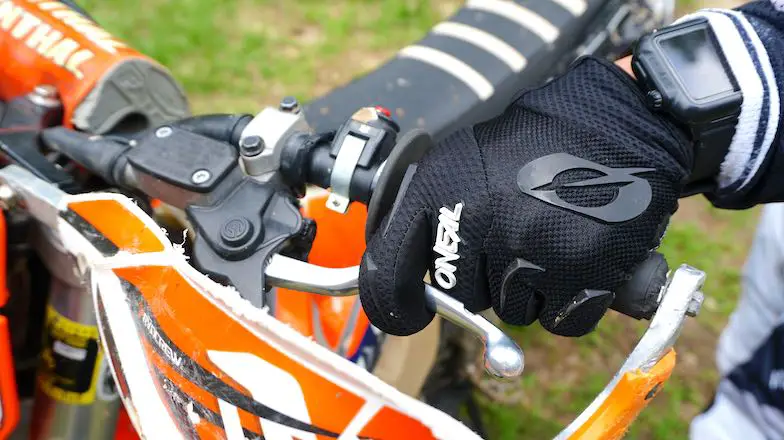
What Is a Clutch Friction Point?
The clutch friction point is the area between the point when the clutch is beginning to pull the dirt bike forward and the clutch is no longer slipping and is fully engaged. Learning to find the clutch friction point is key to learning how to ride a clutch dirt bike.

What Does Clutch Drag Mean?
Clutch drag means a poorly adjusted clutch lever, where the dirt bike is wanting to move forward when in gear even when the clutch lever is fully pulled in to the handlebar. Adjust the clutch lever friction point forward to get rid of clutch drag.
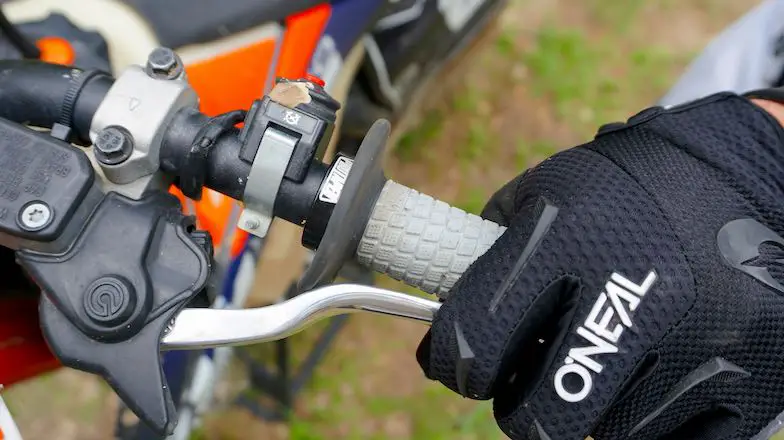
What Is Neutral?
Neutral is a short way of saying that the dirt bike or a motorcycle is not in any gear, but in neutral. The neutral is an area between 1st and 2nd gear. The first gear is down and rest of them are up. To set the dirt bike or motorcycle to neutral, pull the clutch lever in fully, then push the gear lever down to reach 1st gear. Then slowly pull the gear lever upwards with your boot to reach the slot between first and second gear.
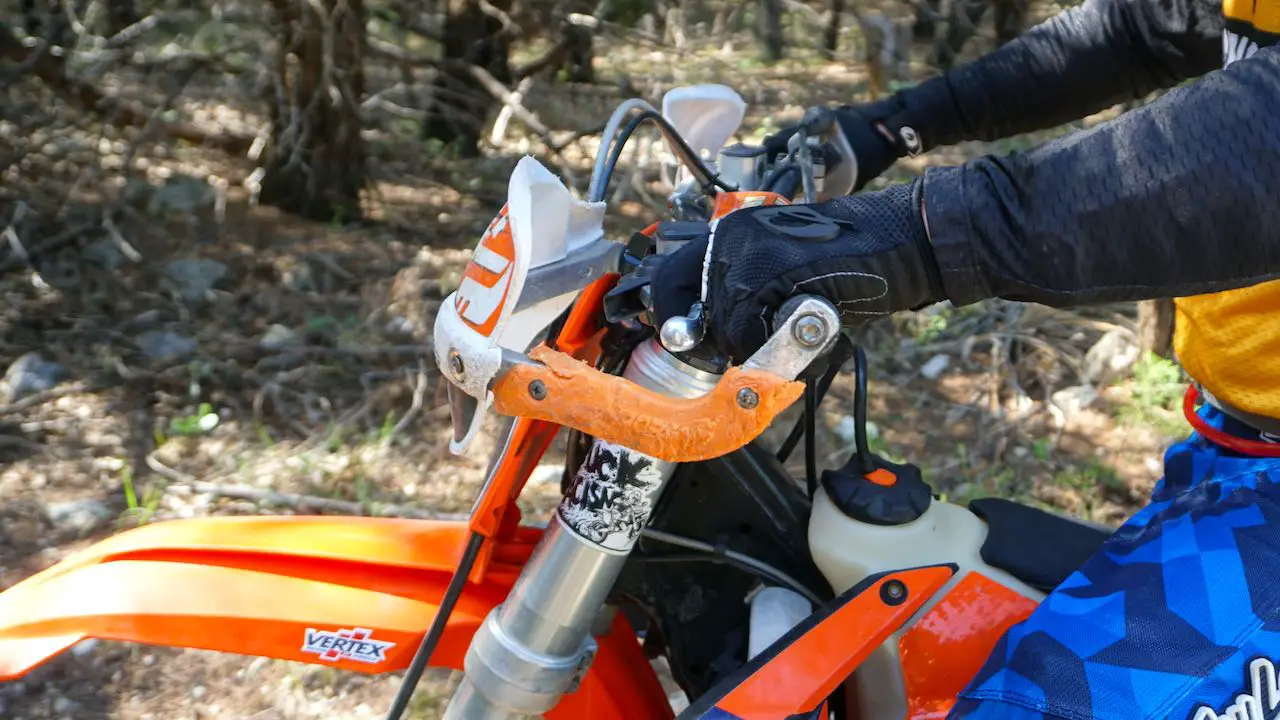
Learn How To Ride a Dirt Bike With a Clutch for Beginners
Next, let’s go through a step by step process on how to ride a dirt bike with a clutch for beginners
1. Find a Safe Place To Practice
Learning how to ride a clutch dirt bike will take some time, but basically you should learn it fairly easily within the first day.
We recommend gearing up and wearing at least the essential dirt bike gear to protect yourself while practicing.
Find an open area where you can begin with learning the clutch basics and safely learn how to ride a clutch dirt bike.
2. Start With a Dead Engine Exercise
This exercise is teaching you how the clutch works and how to find the clutch friction point. It is maybe the most important thing to learning how to ride a clutch dirt bike.
The first step is to set the dirt bike onto a level ground and practice finding the clutch friction point with a dead engine. Yes, keep the dirt bike off for this step. For short riders our there, you can use large rock or a log or similar to place your left leg on. This will makes it easier to reach the seat better and remain stable during the exercise.
Place your left leg on the ground and the right leg on the foot peg ready to use the rear brake to stop the dirt bike or motorcycle.
Begin by rocking the dirt bike back and forth using your left leg. Move about 1-2 feet forward and let the dirt bike rock back.
Next, pull the clutch lever in, push the gear lever down with your boot to engage 1st gear. With the clutch lever pulled all the way in, keep pushing the dirt bike forward and back. Slowly depress the clutch lever until you can feel the drag slow down the dirt bike movement. Once you find the area of increasing resistance, you are using the friction point on the clutch.
Practice until you can reliably recognize the clutch friction point and use it to slow down and stop the dirt bike from moving.
Goal for this stage is to find the clutch friction point before you learn how to ride a clutch dirt bike.
3. Use the Clutch Friction Point To Move the Dirt Bike
Next, we will repeat the exercise with the engine on.
Begin by using the same level ground or a slight incline for this exercise. Put the dirt bike or motorcycle to neutral.
Next, start the engine. When you are practicing, it is always a good idea to pull the clutch in fully when starting the dirt bike / motorcycle. This ensures, that in case you are in fact not in neutral, the dirt bike will not run off and cause a crash.
With the engine idling, pull in the clutch fully. Push the gear lever down to set it in first gear.
Next, while idling (do not add gas), slowly move the clutch lever out, where it is beginning to reach the friction point and then stop moving the clutch. Let the dirt bike creep forward, then pull in the clutch.
You should move only 1 or 2 feet and then let the dirt bike roll back into position while keeping your left leg in place. Repeat and gradually increasing the clutch depressing to get a more stronger pull and movement.

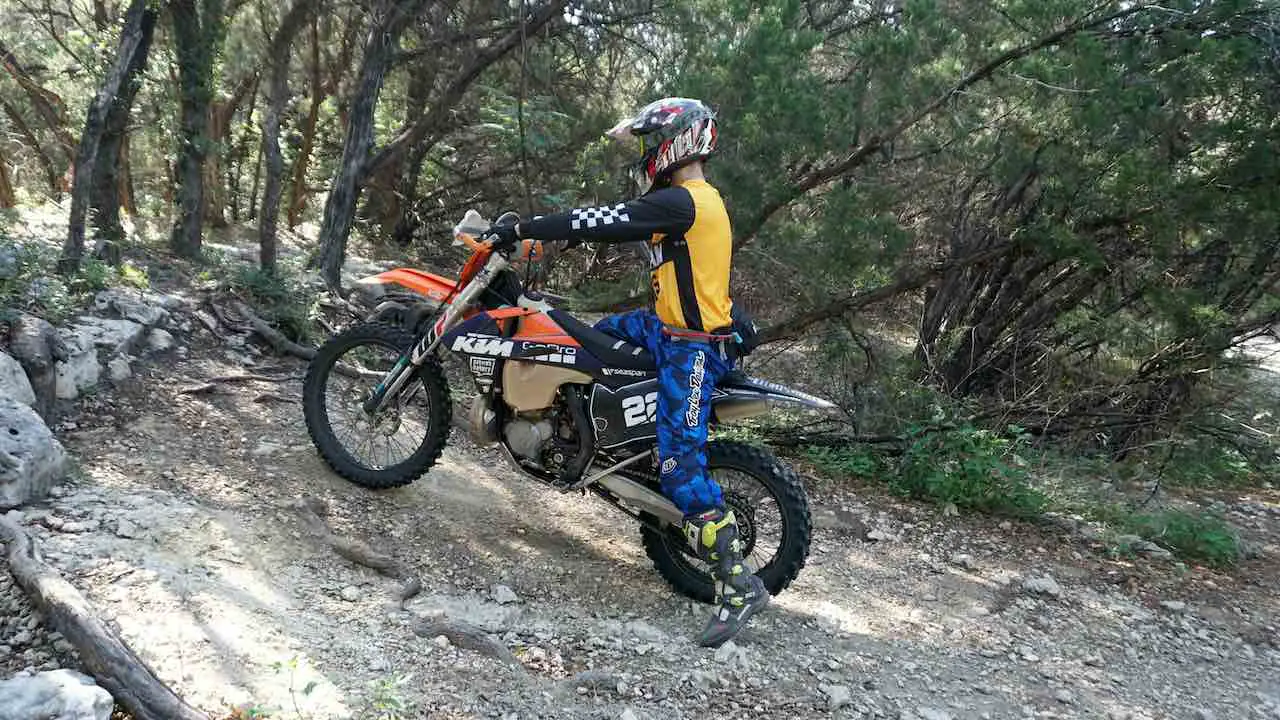
Continue to practice the clutch finger movement until you can comfortably move the dirt bike forward and back without stalling. Take frequent breaks as using the clutch with one or two fingers can be tiring.
The goal for this stage is to find and use the clutch friction point to engage the motor reliably. This helps in learning how to ride a clutch dirt bike as using the clutch is key to success.
4. Practice Starting and Stopping
Next, we will use the clutch and gas to start and gain speed and safely stop the dirt bike.
This exercise is a continuum of the two previous stages. Begin in an open area and start the dirt bike on neutral.
To begin, pull the clutch in and set it to first gear. You are going to do the same thing as with the previous exercise to begin moving the dirt bike.
Next, add a small amount of gas. You only need to add about 5% of more gas, just off idle to move the dirt bike. Then gradually depress the clutch lever to reach the friction point and you can feel the dirt bike starting to move forward. HOLD THIS POSITION! Do not move the clutch lever, let it go or add more gas. This will only cause you to gain speed too quickly.
Let the dirt bike move forwards about 10 feet and then slowly move the clutch lever out more and add some gas to increase speed. You should be now moving enough to lift your left leg onto the pegs and ride it out.
Coming to a stop means using the clutch again. This time, when you want to stop, pull the clutch in completely and then use the rear and front brakes to come to a stop.
If you find it difficult to get started, you can use the previous exercise to rock the dirt bike forward and back a couple of times and then take off on the third time to gain initial speed easier. This will make it easier to learn how to ride a clutch dirt bike.
Frequently Asked Questions About Learning How To Ride a Clutch Dirt Bike
- I stall the dirt bike a lot. You do not need to add more gas! Instead, let the clutch out slower. When you find the friction point, hold the clutch at that position until the dirt bike is moving. Think of the clutch out process as a long rubber band instead of a switch and you will get the hang of it quicker.
- I cannot start without falling. If the dirt bike runs out from under you or you drop the dirt bike, you likely had too much gas. Again the same issue, less gas and more clutch control is the answer.
- The clutch lever is hard to operate. If you cannot reach the clutch lever or it is not comfortable to operate, you should adjust the clutch lever position and reach. Also flush old clutch fluid or grease the clutch cable.
- How much is enough gas? Well, when you get better at clutch control you realize that you don’t need any gas to move the dirt bike, it is all clutch. Now, realistically speaking, the correct amount of gas is around when you can hear the dirt bike engine RMPs increasing slightly off the idle.
- I cannot pull the clutch in with using only index finger. Now, you are supposed to be able to pull in the clutch using only one finger. We recommend using the index and middle finger first and then slowly working your way to using only the index finger.
- I cannot find neutral. You can use your left hand to put the dirt bike gear into neutral as using the hand makes it easier to find the notch between the first and second gear. You can also rev the dirt bike slightly to make the transition to neutral easier.
Advanced Tips on How To Ride a Manual Dirt Bike
Learning how to ride a manual dirt bike takes some time on the seat, however there are several steps you can do the learn faster and make it easier to practice the clutch operation and using gears.
1. Adjust the Dirt Bike Clutch Lever Position and Reach
Good clutch control starts with a correct handlebar position and setting up the forward controls to fit your hands. The clutch lever can be adjusted in several different ways to fit your arms, finger length and lever reach. The angle and position on the handlebars is also important and should be adjusted correctly to your height.
Unless you adjust the forward controls to fit your hands and upper body, it can be difficult to learn how to ride a manual dirt bike, primarily because of how it affects the use of clutch and brake levers. Most beginners tend to grab the clutch lever with three or four fingers, which makes precise clutch control very difficult.
Proper technique, handlebar and clutch/brake lever positioning will make it easier to learn how to ride a manual dirt bike. So, pay attention to how the clutch lever and handlebars need to be set to make it easier to learn the basics of riding a manual dirt bike with a clutch and gears.
Adjust the clutch lever in the handlebar so that your index finger reaches the clutch lever easily. Check that the clutch is fully disengaged when the clutch lever is pulled in against your middle finger. Check that the clutch is barely touching the grip donut area. The lever angle is also important. The clutch lever should be angled only slightly downwards.
For more instructions how to adjust your levers for an optimal position, check out our detailed guide for setting up dirt bike handlebars for trail riding and our ultimate brake and clutch lever positioning guide.
2. Flush Clutch Fluid or Grease Clutch Cable for Lighter Clutch Pull
The clutch pull can wear out even the most experienced dirt riders. Riding dirt bikes means, that you will operate the clutch very frequently, which not only takes skill, but requires strength and stamina from the riders.
Using the clutch in a precise and controlled matter is one of the most difficult things to master on a dirt bike when learning how to ride a manual dirt bike. Practice makes perfect, however lets first make sure the clutch works the way it should and is as easy to pull in as possible.
If the clutch lever feels difficult or hard to pull in or is spongy or changes over time, you should flush the clutch fluid.
In case of cable clutch, check the cable clutch wire and housing for kinks or breakages and replace if necessary. The clutch operation should feel consistent and light and should not change while riding the dirt bike. The clutch fluid may have air build up or is contaminated.
Flush the clutch fluid and bleed it well for proper operation. Also, check your motor oil for proper oil level and replace frequently per user manual recommended interval. The wet clutch in dirt bikes are using the motor oil to lubricate the clutch plates and old oil can affect the clutch friction point operation.
3. Practice One Finger Clutch Operation
For a beginner, learning one finger clutch operation can be a difficult task. But it doesn’t need to be. Once you have setup the clutch properly, using the clutch should be easy. The clutch lever pull should be relatively light to operate with two fingers and is a good starting point.
Use your index and middle finger to start with. Over time, use the index finger more and more as you are getting better and stronger.
You can start with two finger clutch operation to make it easier to first begin learning how to ride a manual dirt bike.
Once warmed up on the trails, use only index finger when riding in relatively easy terrain. When you feel fatigue in your hands or clutch finger, switch to two finger clutch operation. Slowly over several weeks, you will use more and more one finger clutch operation. Over time, you will experience more precise and controllable clutch control using only the index finger.

The benefits of using only one finger to operate the dirt bike clutch is the better, more precise feedback from the friction point and being able to grip the handlebar using three fingers. This usually helps with arm pump and arm fatigue. If you are experiencing arm pump, read our post about arm pump: what is it and how to get rid of it.
4. Find Dirt Bike Clutch Friction Point
Most technical riding techniques require precise clutch control. Going over obstacles, such as logs, ledges and rocks usually involve using the clutch to modulate the power delivery. Learning, adjusting and using the friction point is important and luckily there are several methods to practice and get better at using the dirt bike clutch.
Our favorite clutch operation exercise is to find a small and smooth incline and use the clutch friction point to rock the dirt bike back and forward. This is one of the easier ways to master clutch control when learning how to ride a manual dirt bike.


Set your dirt bike on a small incline. Place your left leg on a stable position near the left foot peg or slightly forward. Without lifting or moving the left leg, use the clutch to slowly move the dirt bike forward about a foot length. Pulling the clutch slightly in, let the bike roll back into initial position. Repeat the process. Use only low revs as this exercise does not require lot of power.
The goal for this exercise is to find and use the dirt bike clutch friction point to rock the bike forward and back. Move slowly without stalling the dirt bike or losing control. The key is to be able to find comfortable clutch operation and repeatedly be able to move the bike slowly forward and slowly back into initial position.
You can use this skill in many areas in the trails. This skill will also help you prevent the dirt bike from rolling backwards in the future and to prevent stalling.
5. Practice Lifting the Front Wheel
This next exercise is very similar to the previous one, but also improves your body control when learning how to ride a manual dirt bike.
Find a small, 4 to 8 inch ledge or an incline that has a step-up. Start with a smaller step up and work your way to bigger ledges and you will notice how it gets easier to control the front end.
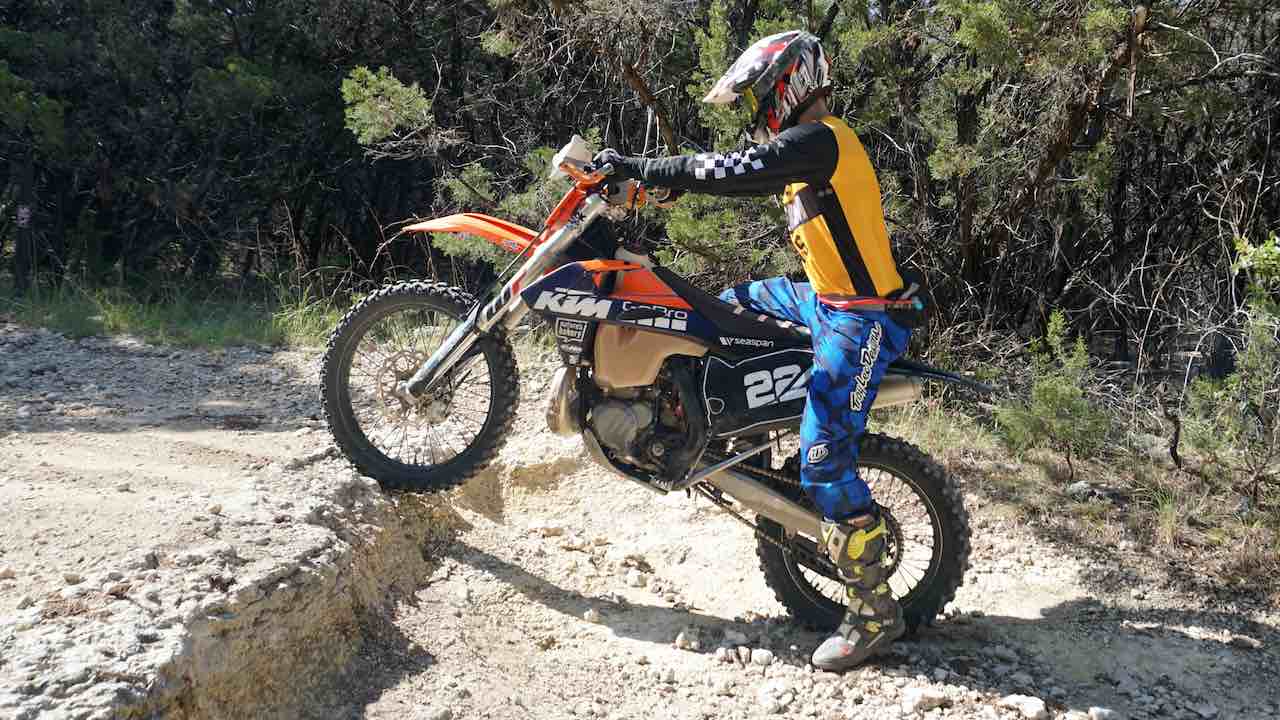
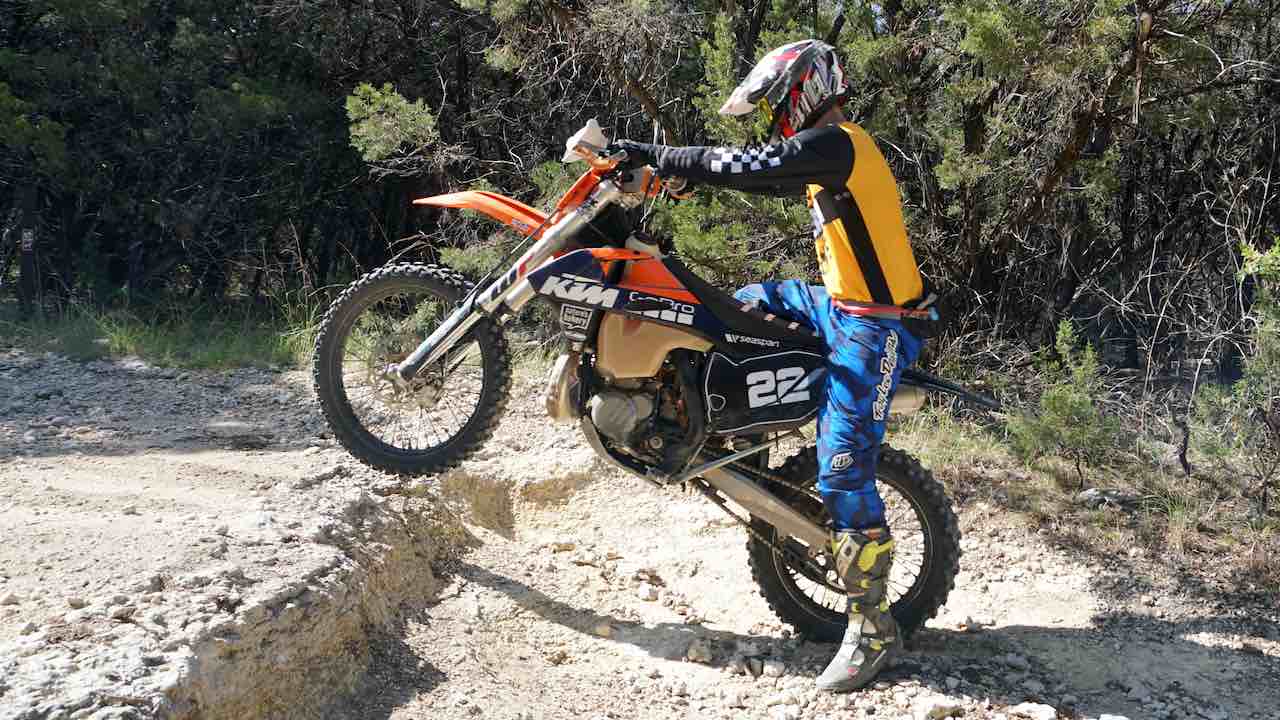
Place the front wheel on the corner of the ledge and use the front brake to hold the front wheel locked during the entire exercise. Place your left leg next the rear axle. Sit back on the seat, almost on the fender. If you are shorter and cannot reach the ground well, place a steady rock under your left leg to sit comfortably on the back of the seat.
Now, similarly to rocking the bike forward with the clutch, use slightly elevated engine revolutions and release the clutch out slightly quicker but not fully out. Pull the clutch in to drop the front end back down. The goal is to give it a short and controllable burst of power using the clutch in the friction area.
Keep your upper body stationary and do not move forward with the dirt bike. It should almost feel like the dirt bike runs out under you or rotates around and you lift the front end with your arms, rather than you moving forward with the bike.
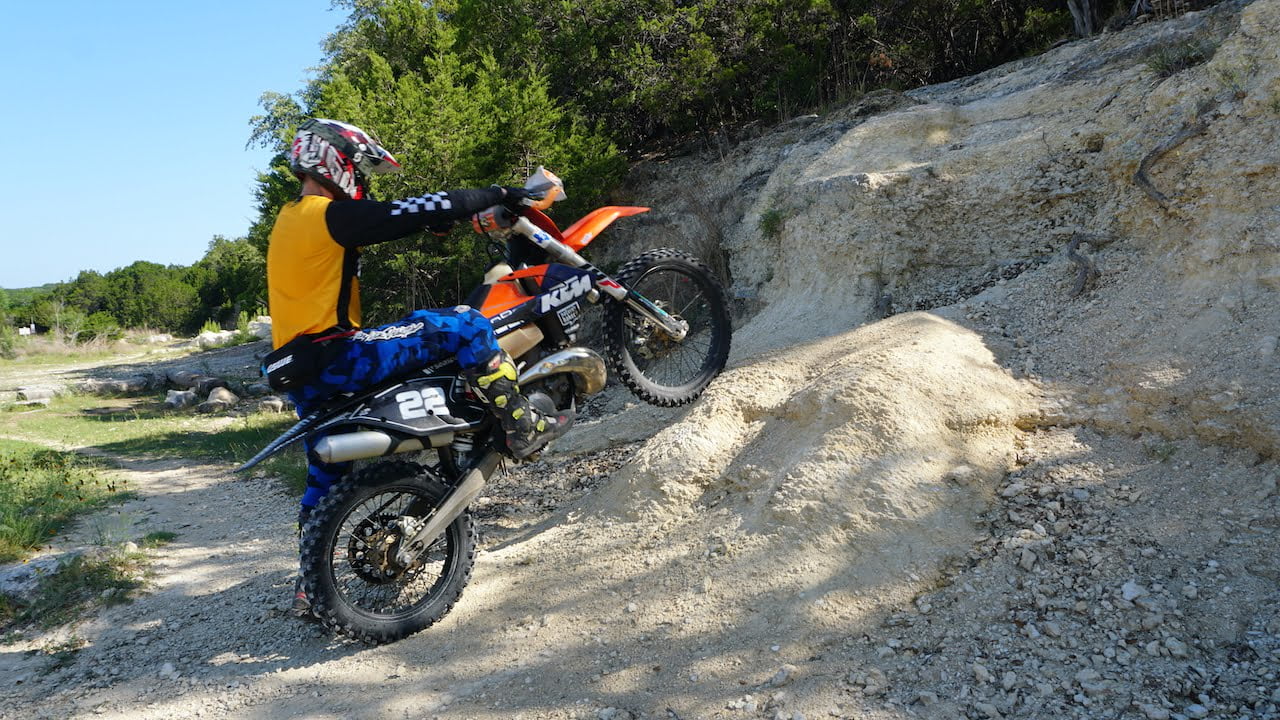

6. Using Clutch and Gears in Various Speeds
After you learn how to ride a manual dirt bike, using the clutch becomes more of a side thought and it no longer takes effort at all.
When you ride dirt bikes, you quickly realize that the clutch is used mostly to start, stop and perform different techniques with the dirt bike on the trails and going over obstacles. Modern dirt bikes are built tough and allow operating the gears without using the clutch. Once you get some speed and begin operating at higher speeds and higher gears, your clutch use also evolves.
It is not necessary to always use the clutch when changing gears. Once you are going at a slightly higher speed, the clutch use changes. Its primary function is to control the power delivery as part of the riding techniques and preventing stalling. Using the clutch is no longer needed when you shift up or down, if you slightly let go of the gas and match the current engine revolution speed. Most riders tend to slightly pull the clutch in when shifting but it’s not needed when you practice timing and releasing the pressure while shifting.
Conclusions
Learning how to ride a clutch dirt bike takes some effort, but with these exercise you can learn how to use the clutch and gear.
Precise dirt bike clutch control is also key to improving your riding skills. Use these exercises to improve your clutch control whenever you go out riding. Add the ledge exercise to your warmup routine and you will be amazed how quickly it will help you get better over a few weeks. It only takes about 5 to 10 minutes each time you go out to ride.
Keep slipping that clutch!
Read next:
- Single track riding tips for beginners
- Top 5 static balance exercises to improve trail riding
- Arm pump: what is it and how to get rid of it
- Best beginner dirt bikes for trail riding and motocross
- Best dirt bikes for women for trail riding and motocross
- The ultimate guide to dirt bikes for 7-year-olds and under
